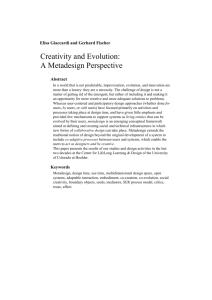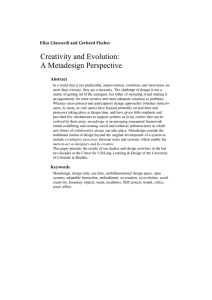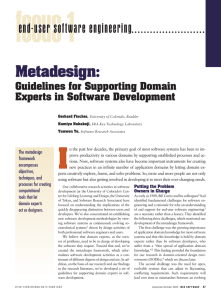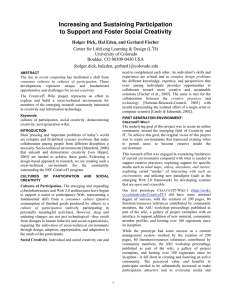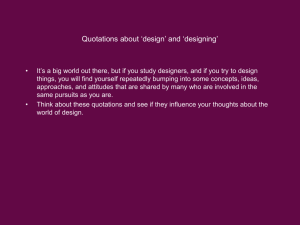Creativity and Evolution: A Metadesign Perspective
advertisement
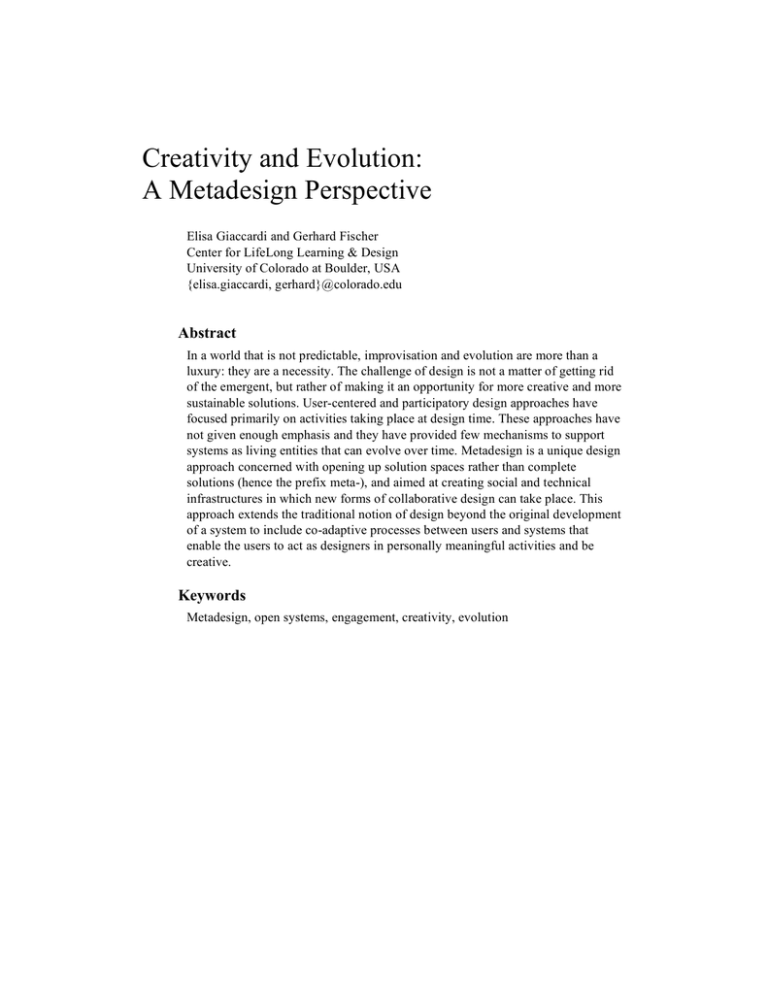
Creativity and Evolution:
A Metadesign Perspective
Elisa Giaccardi and Gerhard Fischer
Center for LifeLong Learning & Design
University of Colorado at Boulder, USA
{elisa.giaccardi, gerhard}@colorado.edu
Abstract
In a world that is not predictable, improvisation and evolution are more than a
luxury: they are a necessity. The challenge of design is not a matter of getting rid
of the emergent, but rather of making it an opportunity for more creative and more
sustainable solutions. User-centered and participatory design approaches have
focused primarily on activities taking place at design time. These approaches have
not given enough emphasis and they have provided few mechanisms to support
systems as living entities that can evolve over time. Metadesign is a unique design
approach concerned with opening up solution spaces rather than complete
solutions (hence the prefix meta-), and aimed at creating social and technical
infrastructures in which new forms of collaborative design can take place. This
approach extends the traditional notion of design beyond the original development
of a system to include co-adaptive processes between users and systems that
enable the users to act as designers in personally meaningful activities and be
creative.
Keywords
Metadesign, open systems, engagement, creativity, evolution
Introduction
Design is generally conceived as the conception and planning of the artificial: a
normative form of science in contrast to natural sciences (“how things ought to be”
versus “how things are”) (Simon 1996). Today, however, design is also
characterized as a humanistic enterprise in which the subject matter is not fixed
(Buchanan & Margolin 1995): an inquiry and experimentation in the activity of
making (“how things might be”), which is meant to envision and elaborate
possibilities in order to allow people to experience the world in greater and richer
ways (Maturana 1997).
In the context of such a design discourse, and related design methodologies (Cross
1984), the idea of metadesign proposed in this article originates inside a linguistic
inheritance and intellectual debate calling for a democratization of the creative
process of invention, and leading to a strong sense of design as a “change of place,
order, or nature”—matching ideas of design as improvisation, modification, and
evolution (Giaccardi 2005).
It is our belief that improvisation and evolution are more than a luxury: in a world
that is not predictable (Suchman 1987), they are a necessity. The challenge of
design is not a matter of getting rid of the emergent, but rather of making it an
opportunity for more creative and more sustainable solutions.
In the attempt to create more adequate solutions, user-centered and participatory
design approaches have focused primarily on activities taking place at design time,
and have given little emphasis and provided few mechanisms to support systems
as living entities that can evolve over time. Our metadesign approach, on the
contrary, is concerned with opening up solution spaces rather than complete
solutions (hence the prefix meta-). The challenge is to create social and technical
infrastructures that enable users to cope with the emergent aspects of reality and
allow them, when needed and desired, to act as designers and be creative (Fischer
& Giaccardi 2006). We advocate metadesign as a unique design approach in which
new forms of collaborative design can take place by redistributing design
activities over time and at different levels of interaction with the environment.
This article highlights the relationships between creativity and evolution in our
conceptual framework, stressing the role of situated actions and emergent
opportunities in the creative evolution of our socio-technical environments. The
first part of the article is more theoretical and describes our conceptual framework.
The second part provides an overview of the methods, techniques, and support
mechanisms that we have identified and used to strengthen the link between
creativity and evolution that is fundamental to metadesign. In this second part,
examples are drawn from system-building activities and studies in open source
development and digital arts conducted at the Center for Lifelong Learning &
Design (L3D) over the last two decades.
2
Foundational Concepts for Metadesign
Metadesign supports improvisation and change to fit the new needs and
opportunities that arise during the use of artefacts. In doing so, metadesign
addresses critical design challenges, including:
Coping with Ill-Defined Problems. Complex design problems are ill-defined
(Rittel & Webber 1984). Because they are not understood well enough to be
described in sufficient detail, they cannot be specified accurately in advance,
and systems cannot be built faultlessly. The integration of problem framing
and problem solving is vital to design and cannot be delegated (e.g., from
users to professionals).
Supporting Reflective Practitioners. Schön characterizes design as a reflective
conversation with the materials of the design situation (Schön 1983).
Designers gradually build their understanding of a design problem and its
solution by thinking about what they are doing while doing it, in such a way as
to influence further “doing”. Being able to create and arrange over time the
materials of the design situation is crucial to reveal new opportunities and
envision emergent possibilities.
Design as a Collaborative Process. Complex design problems require more
knowledge than any single person can possess, and the knowledge relevant to
a problem is often distributed among stakeholders with different perspectives
and backgrounds (Salomon 1993). Bringing together individuals with different
knowledge, abilities, and motivations is critical to generating more creative
and sustainable solutions.
In summary, users’ situations and needs cannot be fully anticipated because they
are ill-defined and change over time. Users need to be engaged in problem framing
and problem solving both when the system is designed and when the system is
used (Fischer 2002). Moreover, keeping the system open to the contributions of
diverse individuals is essential to support unplanned and even subversive uses that
may lead to more creative and sustainable results. In a world in which solutions
are neither given nor confined in one single mind (Bennis & Biederman 1997), the
possibility for users to act as owners of problems and migrate from consumers to
designers provides the foundation for an unselfconscious culture of design
(Alexander 1964). In such a culture, inadequacies or unexpected opportunities lead
spontaneously to an action to change or improve the system.
Design Time and Use Time
In conventional design approaches, two basic stages can be differentiated: design
time and use time. At design time, with or without user involvement, designers and
developers create complete systems for the world as they envision it (the world-asimagined). At use time, users utilize the system; but because their needs,
objectives, and contexts can be anticipated only partially at design time (Suchman
1987), the system often requires modification to fit the users’ needs (Nardi &
O’Day 1999).
3
In our framework, systems are not completely designed prior to use: users can
directly experience their own world (the world-as-experienced) and accommodate
unexpected issues at use time. Metadesign is fundamentally different from creating
complete systems: rather than developing complete solutions, it means developing
socio-technical environments that allow users to create the solutions themselves. It
is not less design, but a different kind of design.
Metadesign is an emerging conceptual framework aimed at defining and creating
social and technical infrastructures in which new forms of collaborative design
can take place by redistributing design activities at different times and levels of
interaction with the environment. In contrast, user-centered and participatory
design approaches have focused primarily on activities and processes taking place
at design time, and have given little emphasis and provided few mechanisms to
support systems as living entities that can evolve over time. In user-centered
design (Norman & Draper 1986), designers generate solutions that place users
mainly in a reactive role. In participatory design (Schuler & Namioka 1993),
designers seek to involve users more deeply in the process, as co-designers. But
the focus remains on design time, when designers and users are brought together to
envision future contexts of use, and users are empowered to propose and generate
design alternatives themselves.
Despite the best efforts at design time, systems need to be evolvable to fit
emergent needs, account for changing tasks, and couple with the domain in which
users are situated (Fischer 1998). Metadesign shares some important objectives
with user-centered and participatory design approaches, but it transcends them in
several important dimensions. For example, metadesign creates open systems that
can be modified by their users and evolve at use time, supporting more complex
interactions. This changes the processes by which systems and content are
designed and intentionally shifts some control from designers to users, enabling
users to create and contribute their own visions and objectives, keeping the world
and the system in sync.
The Art of Open Systems
Environments supporting creativity and evolution need to be open systems—
allowing users to modify contents and functionalities as they use the system to
solve problems. Open systems provide opportunities for significant changes to the
system at all levels. Over the years, our research has identified the following
principles for the development of open systems (Fischer 1998):
Software systems must evolve; they cannot be completely designed prior to
use. Designers and developers cannot anticipate and plan for every possible
situation. To apply to different circumstances and facilitate the construction of
new situations, systems must be conceptualized as seeds (described later in
this article).
4
Systems must be designed for evolution. Extending an application in an
initially closed design is difficult because of the assumptions implicit in a
system designed without extension in mind. Designing a system for evolution
from the ground up can provide a context in which change is expected and can
take place.
Systems must evolve at the hands of the users. Giving users the ability to
change the system as they explore their problem space provides insights that
are unique to those experiencing the problems.
Evolution of systems must take place in a distributed manner. Users are
distributed in space, in time, and across different conceptual spaces (i.e., with
different backgrounds and perspectives). This distribution is fruitful to create
opportunities for evolution and generate more creative and sustainable
solutions (Fischer 2005).
A Multidimensional Design Space
In an open system, redistributing design activities between design time and use
time encompasses a multidimensional design space (Giaccardi 2004), comprising
three interdependent planes of design that can be summarized as follows:
Designing Design
This plane of design supports the modifiability of computational structures
and the malleability of social infrastructures. It entails anticipatory methods
and techniques for the design of the design process. At this level,
metadesigners must anticipate both users’ needs (to some extent) and provide
for the potential changes that may occur at use time. Metadesigners play an
important role in setting the conditions that will allow users in turn to become
designers and in creating a good seed (described later in this paper; see also:
Fogli & Giaccardi 2007); the possibility of modifying the system that is
provided at this level must allow users to respond to the mismatch between
what can be foreseen at design time and what will emerge at use time.
Designing Together
This plane of design defines the way in which metadesigners and users can
participate together in the design activity. It entails participative methods and
techniques for the metadesigners to let the users be involved in the initial
setting at design time, and related support mechanisms (such as critics and
reuse, described later in the article) to enable users to learn and in turn become
active contributors and eventually designers at use time. At this level,
metadesigners and users play a fluid role in collaborative design, being able to
intervene at different times and levels of social interaction (i.e., as an
individual or a community).
Designing the In-Between
This plane of design defines how people can experience and negotiate their
relationships and socially engage in meaningful activities. It entails affective
5
methods and techniques (such as the use of mediators and related support
mechanisms, described later in this article) aimed at supporting and
facilitating sensorial and emotional responses and sustaining users’
engagement in collaborative practices. At this level, users’ interactions with
the socio-technical environment are crucial in opening up the system to
unintended and creative uses.
Creativity and Evolution in the Metadesign Framework
Given the outlined conceptual framework, how are creativity and evolution linked
in metadesign? How can this link be sustained and promoted?
In the analysis of the relationships between creativity and evolution, it has been
emphasized that in order to support open-ended and creative evolution it is
fundamental for individuals to be part of the environment experienced by other
individuals (Arthur 1994; Taylor 2002). According to Taylor, the “fundamentally
new” of an open-ended and creative evolution refers to “the ability of individuals
to interact with their environment […] with few restrictions and to evolve
mechanisms for sensing new aspects of this environment and for interacting with it
in new ways” (Taylor 2002, p. 81). The embodiment and richness of interactions
that will lead individuals to the ability to perform new tasks are crucial. In our
socio-technical environments, we share this belief by promoting situated processes
and emergent opportunities (Fischer & Giaccardi 2006), and supporting users’
engagement and sustained participation (Fogli & Giaccardi 2007) in the sociotechnical environment. This section provides an understanding of evolution and
creativity in the metadesign framework; methods, techniques, and support
mechanisms are detailed in the following sections.
The open systems created by metadesign link creativity and evolution in that they:
(a) promote the transcendence of the individual mind by supporting the differences
in knowledge, abilities, and motivations that exist among users; (b) support
sustained participation by facilitating users’ engagement in personally meaningful
activities; and (c) enable the mutual adaptation and continuous evolution of users
and systems by allowing users to evolve new ways of interacting with the sociotechnical environment and enabling systems to adapt to users’ changing needs and
practices.
Transcending the Individual Mind. In a world in which solutions are neither
given nor confined in one single mind, we need to expand the creative process
beyond the individual mind (Arias et al. 2000; Fischer 2006). The distribution of
different knowledge, abilities, and motivations that exist in individuals is critical
for users to engage in personally meaningful activities, to collaborate, and to
evolve (Fischer & Giaccardi 2007). A good example is the development of open
source software (Raymond & Young 2001), in which the sharing of source code
allows others to go forward, whereas the original developer cannot or does not go
further due to reasons such as loss of interest, time constraints, or a lack of new
ideas. Another good example involves creative practices such as art and
technology collaboration (Mitchell et al. 2003), the results of which supersede
6
what a single artist or computer scientist could have done in isolation.
Environments for mass collaboration and social production (Tapscott & Williams
2006), such as annotated collections (GenBank), media sharing (Flickr and
YouTube), wikis (Wikipedia), folksonomies (del.icio.us), and virtual worlds
(Second Life) are other good examples of how the diverse and collective stock of
scientific content and artistic or stylistic ideas that individuals and communities
share, re-interpret, and use as a basis for new ideas and visions constitutes the vital
source of creativity and evolution.
Engaging in Meaningful Activities. Users need to be able to express themselves
and engage in personally meaningful activities to act as designers and be creative.
To do so, they need to be actively engaged in the system of social and material
relationships provided by the socio-technical environment. In relation to this
engagement, we have adopted the notion of co-creation (Giaccardi 2004; Candy &
Edmonds 2002). Co-creation has to do with the collaborative construction of
personally meaningful artefacts and activities, and is enabled by the users’
capability to share emotions, experiences, and representations with or without any
central guidance towards specific objectives or determined strategies. Good
examples are distributed systems for visual interaction in the arts (Wilson 2002).
These systems usually enable a large number of people to participate in the
emergence of an ephemeral visual narrative. The association of each participant
with individual local images, strokes, or colours—and their mutual interactions—
produce a global narrative in which figurative elements, meanings, and stories
emerge and change over time through a process reminiscent of children looking at
clouds.
Coping with Experience. Users also need to be able to cope with experience and
evolve new ways of interacting with the environment. The evolution of a sociotechnical environment is conceived in the metadesign framework as the evolution
of a living entity. In our research, we have carefully analyzed why simulation
environments such as SimCity, for example, are not used for real planning and
working environments. SimCity supports some superficial kinds of modifications
(such as changing the appearance of buildings in the city), but most functional
aspects of the simulation environment have already been determined at the original
design time. For example, the only way to reduce crime in a simulated city is to
add more police stations. It is impossible to explore other solutions, such as
increasing social services. Because the functionality of the system was fixed when
the system was created, exploring concepts that were not conceived by the system
designers is difficult. To support the desired co-evolution (Fischer 1998), it is vital
to extend the traditional notion of design beyond the original development of the
system and include a co-adaptive process between users and a socio-technical
environment in which not only users change by using the system, but also the
system changes at the hand of the users.
In order to pursue these objectives and promote the link between creativity and
evolution in metadesign, we have defined and developed an initial set of methods
and support mechanisms according to the schema shown in Table 1.
7
Table 1: Creativity and Evolution in the Metadesign Framework
Objective
Distribution
Co-creation
Co-evolution
Method
Externalizations
Mediators
Seeds
Support Mechanism
Critiquing
Affect
Reuse
We anticipate this set will continue to grow as we improve our understanding
through further development and assessment.
Need for Externalizations, Mediators, and Seeds
Externalizations. Externalizations (Bruner 1996) are one aspect in particular that
we have explored to support users in expressing their tacit knowledge,
communicating and coordinating their various perspectives, and eventually
activating information relevant to the task at hand. Externalizations are essential to
participation and to the performance of users’ distributed mind (Salomon 1993) in
that they assist in translating vague mental conceptualizations of ideas into more
concrete representations, and provide a means for users to interact with, react to,
negotiate around, and build upon ideas. Externalizations focus discussions upon
relevant aspects of framing and understanding the problem being studied, thereby
providing a concrete ground and a common language among users. For example,
L3D has developed a three-dimensional (3D) sketching pen for the Envisionment
and Discovery Collaboratory (EDC), an environment based on tabletop
technology that allows users to collaboratively frame and solve problems of
mutual interest (Arias et al. 2000).
Figure 1: 3D Sketching in the Envisionment and Discovery Collaboratory (EDC) allows
revealing hidden assumptions and implications of the design situation.
Along with the basic sketching capability of this pen is the ability provided by the
EDC to view these representations in 3D space and enhance the visibility of user
intentions as well as the implications of their actions on the design situation
(Figure 1). The domains explored in the EDC, such as land management, urban
planning, and building design, are all examples of open-ended social problems. In
these contexts, solutions cannot be optimal, but only more or less sustainable,
depending on the participation of diverse stakeholders.
Mediators. Mediators (Giaccardi 2006) are one aspect we have explored to
facilitate users’ engagement in the co-creation of personally meaningful activities.
Mediators are classes of environment excitations dynamically generated over the
course of the interaction by the interplay between affordances and externalizations,
that is, between the capabilities of the tools available for interaction and the
individual representations that users produce during the process of interaction.
Mediators affect participants’ emotional tone and provide a social and dynamic
8
context for the emergence of meaningful activities. Unlike externalizations (which
represent the product of one individual’s perception of the external world),
mediators are generated over the course of interaction as a result of users’ mutual
perceptions and actions. For example, in the distributed applications for visual
interaction previously mentioned, mediators are the pattern of lines and strokes,
the combination of colours, or the set of figurative elements that are generated and
continuously modified by the overall drawing activity of the users. The spatial,
chromatic, or narrative relationships that these structures identify on the shared
canvas elicit the users’ flow of emotions, levels of engagement, and modes of
conduct, and ultimately facilitate or inhibit the emergence of meaningful images
(Figure 2).
(a)
(b)
Figure 2: Olivier Auber, Poietic Generator, http://poietic-generator.net/ (accessed 26
November 2007). Different kinds of space configurations (a) facilitate or
(b) inhibit the emergence of meaningful images on the shared canvas.
Seeds. Conceiving and designing our socio-technical environments as seeds
(Fischer & Ostwald 2002) is the aspect we have explored to support the mutual
adaptation and continuous evolution of users and systems over time. In our
metadesign framework, a seed is not a template or a design schema. Rather, it is a
piece of knowledge, content, or code that can be fundamentally created, evolved,
and recombined by means of mechanisms that allow its sharing and modification.
Seeds keep the system open to be adapted to emerging needs and situations. For
example, the Memory Aiding Prompting System (MAPS) is a system that has been
developed at L3D with the goal of supporting people with cognitive disabilities
and their support communities of caregivers in everyday life (Carmien 2007).
Because the challenge of such an objective is to create tools flexible enough to
adapt to the unique needs of people with cognitive disabilities, MAPS has been
conceptualized and designed as a seed. It provides a simple prompting system for
individuals with cognitive disabilities, along with an editing tool that allows
caregivers to design their own prompting scripts (for example, reminding the
person with cognitive disabilities how to reach the workplace). In this way,
caregivers can directly create, share, and modify scripts while the individuals with
cognitive disabilities and the system co-evolve: the users develop new ways of
interacting with their environment and the system adapts to users’ changing needs
and practices (Figure 3).
9
Figure 3: A user with cognitive disabilities takes the bus on her own and goes to the
recreational centre, developing a more independent way of living.
Support Mechanisms for Critiquing, Reuse, and Affect
While using a system, users will discover mismatches between their needs and the
support that an existing system can provide for them, in terms of both failures and
opportunities. These mismatches will lead to breakdowns and serve as potential
sources of new insights, new understanding, and new knowledge (Fischer 1994).
Critiquing and reuse are mechanisms aimed at supporting transcendence of the
individual mind and allowing users to cope with their emergent needs and
practices. They highlight constraints and potential failures (critiquing), provide
new opportunities for interaction (reuse), and promote the overall co-evolution of
users and systems. Equally important, affective mechanisms allow users to express
themselves and socially engage in the co-creation of meaningful artefacts and
activities.
Critiquing. Computational critiquing mechanisms, or critics (Fischer et al. 1998),
are generally embedded into the software system. They instantiate and transcend
Schön’s theory of design (Schön 1983); they support reflection-in-action and
increase the back-talk of the design situation, which in Schön’s framework is
determined solely by an individual designers’ skills and experience. At L3D, we
have explored the application of critics in a number of specific applications, and in
particular in the context of domain-oriented design environments (Fischer et al.
1998). Domain-oriented design environments are systems that transcend the limits
of the activities envisioned by the developer of a design environment by
supporting the integration of construction and argumentation. They provide
information repositories to store and share domain knowledge, and allow designers
to accumulate additional knowledge through interaction with the environment.
This is made possible by computational critiquing mechanisms, which analyze an
artefact under construction, signal breakdown situations to the designer, and
10
provide entry points to the space of argumentation directly relevant to the design
situation.
Hydra (Fischer et al. 1998), for example, is a domain-oriented design environment
for kitchen design developed at L3D. In this environment, critics not only reflect
knowledge that applies to all designs, such as accepted standards, building codes,
and domain knowledge based on physical principles, but also externalize design
knowledge that is tied to the specific characteristics of the actual design situation.
Moreover, critics support design as an interpretive process by allowing designers
to interpret the situation from different perspectives according to their interests. In
a perspective concerned with resale value, for instance, critics about where the
dishwasher and sink might be placed are redefined, and the designer will be
informed whenever a feature that would negatively affect resale value is detected.
Reuse. Reuse (Ye & Fischer 2002) provides the opportunity to exchange and
manipulate seeds. We can find good examples in both digital arts and open source
software development. A peculiar example of reuse is, for example, Face Poiesis,
an art system by Japanese artists Toshihiro Anzai and Rieko Nakamura. By means
of an original painting system, the two artists compose faces by mixing features
(such as face shapes, hair, lips, eyes, and other traits) from faces previously
created by the artists themselves. The idea is to create a pool of arbitrary
individual pieces called pixema (seeds in our context), which can be freely
identified and exchanged in order to synthesize new paintings (Figure 4 and Figure
5). The results are unexpected and surpass what one single artist might have
produced in isolation.
Figure 4 and Figure 5: Toshihiro Anzai and Rieko Nakamura, Face Poiesis,
http://www.renga.com (accessed 26 November 2007). Arbitrary features are identified and
exchanged in order to synthesize new faces.
Another example of reuse is CodeBroker (Ye & Fischer 2002), an active
component repository system for Java programmers developed at L3D.
CodeBroker monitors a software developer’s programming activity, infers the
developer’s immediate programming task by analyzing semantic and syntactic
information contained in his or her working products, and actively delivers taskrelevant and personalized reusable parts from a reuse repository created by
decomposing existing software systems. CodeBroker conceptualizes software as a
11
seed. When the seed is distributed and shared by other interested users and
software developers, users and software developers are able to interact with the
system and use it creatively in more situations than the original developer had
intended.
Affect. Affective mechanisms support mutual interaction, facilitating users’ active
engagement into the socio-technical environment (Giaccardi 2006a). One specific
example of an affective mechanism is emotional tuning, which facilitates the
arousal of an interaction’s emotional tone. Emotional tuning enables users to
experience the temporal and spatial features of the environment in which they are
interacting in terms of proximity (or intimacy) and intentionality; that is, in terms
of how “closely” users interact with each other in the information space, and how
users’ chains of actions can be consistently interpreted as intentions and lead over
time to meaningful events. Interesting examples of emotional tuning can be found
in the digital arts. As an example, Open Studio is a Java-based drawing system by
Andy Deck that concurrently links up users to a single pictorial interface, and
allows them to participate in the creation of a graphic animation. In Open Studio,
the drawing tools have been designed to be expressive of users’ movements,
reacting to the different speeds, directions, and curves of their physical gestures.
The visual behaviour expressed by the bodily quality of the strokes, marks, and
colours drawn by users on the shared canvas affects users’ emotions and
intentions, influences the overall emotional tone of the interaction, and
consequently encourages or discourages the emergence of meaningful visual
narratives (Figure 6). Examples of affective mechanisms in larger and more
complex socio-technical environments are described elsewhere (Giaccardi 2006b;
Giaccardi 2007).
(a)
(b)
Figure 6: Andy Deck, Open Studio, http://artcontext.org/draw/ (accessed 26 November 2007).
Different qualities of strokes and marks influence the emotional tone of the interaction, (a)
encouraging or (b) discouraging the emergence of visual narratives.
Conclusions
This article has focused on the co-creative and co-evolutionary aspects of the
metadesign framework. It has provided concepts, methods, and support
mechanisms to link creativity and evolution in collaborative design, drawing
examples from the studies and design activities pursued at the Center for LifeLong
Learning and Design (L3D) over the last two decades. This work strengthens the
relationships among open systems, creativity, and evolution in an attempt to
12
promote and advance a coherent conceptual and methodological framework of
metadesign. Of course, to make metadesign more ubiquitous, the forces that
prohibit or hinder creativity and evolution must be understood and addressed.
Examples of such forces are: (a) the resistance to change, because metadesign
requires learning efforts and may create unknown difficulties and pressures; (b)
the problem of premature standards in technological development; (c) the
difficulties created by installed bases and legacy systems within existing
organizations; and (d) the issue of who are the beneficiaries versus who is doing
the work in order for evolution to occur. An understanding of the related
organizational issues, and the more complex social, cultural, and ethical issues
entailed by these problems will provide a better framework for their solution and
for the further advance of metadesign.
Acknowledgments
A previous version of this article was presented at the 6th International Conference
of the European Academy of Design (EAD06) in 2005. The authors thank the
members of the Center for LifeLong Learning & Design at the University of
Colorado, who have made major contributions to the conceptual framework
described in this article. This research was supported by: (1) the National Science
Foundation grants REC-0106976, CCR-0204277, and IIS-0613638; (2) SRA Key
Technology Laboratory, Inc., Tokyo, Japan; (3) the Coleman Institute, Boulder,
Colorado, USA; and (4) Fondazione Eni Enrico Mattei, Milan, Italy.
References
Alexander, C. (1964) The Synthesis of Form, Harvard University Press, Cambridge,
MA.
Arias, E. G., Eden, H., Fischer, G., Gorman, A. & Scharff, E. (2000) ‘Transcending
the Individual Human Mind—Creating Shared Understanding through
Collaborative Design’, ACM Transactions on Computer HumanInteraction, vol. 7, no. 1, pp. 84-113.
Arthur, W.B. (1994) ‘On the Evolution of Complexity’ in Complexity: Metaphors,
Models and Reality, eds G. Cowan, D. Pines & D. Meltzer, AddisonWesley, pp. 65-81.
Bennis, W. & Biederman, P.W. (1997) Organizing Genius: The Secrets of Creative
Collaboration, Perseus Books, Cambridge, MA.
Bruner, J. (1996) The Culture of Education, Harvard University Press, Cambridge,
MA.
Buchanan, R. & Margolin, V. (eds) (1995) Discovering Design: Explorations in
Design Studies, University of Chicago Press, Chicago.
Candy, L. & Edmonds, E. A. (2002) Explorations in Art and Technology, SpringerVerlag, London.
Carmien, S. (2007) Leveraging Skills Into Independent Living- Distributed
Cognition And Cognitive Disability, VDM Verlag Dr. Mueller e.K.
Cross, N. (ed.) (1984) Developments in Design Methodology, John Wiley & Sons,
New York.
13
Fischer, G. (2006) ‘Distributed Intelligence: Extending the Power of the Unaided,
Individual Human Mind’, Advanced Visual Interfaces 2006 (AVI 2006),
Venice, Italy, pp. 7-14.
Fischer, G. (2005) ‘Distances and Diversity: Sources for Social Creativity’,
Creativity & Cognition 2005, London, UK, pp. 128-136.
Fischer, G. (2002) ‘Beyond 'Couch Potatoes': From Consumers to Designers and
Active Contributors’, FirstMonday, [online], http://firstmonday.org/,
accessed 28 November 2007.
Fischer, G. (1998) ‘Complex Systems: Why Do They Need to Evolve and How Can
Evolution Be Supported’ in Artificial Intelligence in Structural
Engineering, I. Smith (ed.), Springer, Heidelberg, pp. 92-112.
Fischer, G. (1994) ‘Turning Breakdowns into Opportunities for Creativity’,
Knowledge-Based Systems, vol. 7, no. 4, pp. 221-232.
Fischer, G. & Giaccardi, E. (2007) ‘Sustaining Social Creativity’, Communications
of the ACM, vol. 50, no. 12, to appear.
Fischer, G. & Giaccardi, E. (2006) ‘Meta-Design: A Framework for the Future of
End User Development’ in End User Development — Empowering People
to Flexibly Employ Advanced Information and Communication Technology,
H. Lieberman, F. Paternò & V. Wulf (eds), Kluwer Academic Publishers,
Dordrecht, The Netherlands, pp. 421-452.
Fischer, G., Nakakoji, K., Ostwald, J., Stahl, G. & Sumner, T. (1998) ‘Embedding
Critics in Design Environments’ in Readings in Intelligent User Interfaces,
M. Maybury & W. Wahlster (eds), Morgan Kaufman Publishers, San
Francisco, pp. 537-561.
Fischer, G. & Ostwald, J. (2002) ‘Seeding, Evolutionary Growth, and Reseeding:
Enriching Participatory Design with Informed Participation’, Participatory
Design Conference 2002, Malmö University, Sweden, pp. 135-143.
Fogli, D. & Giaccardi, E. (2007). ‘Make it Flourish! Revising the Idea of Seed in
Metadesign’. Unpublished Manuscript.
Giaccardi, E. (2007) ‘Cross Media Interaction for the Virtual Museum:
Reconnecting to Natural Heritage in Boulder, Colorado’ in New Heritage:
New Media and Cultural Heritage, Y. Kalay, T. Kvan & J. Affleck (eds),
Routledge, London, pp. 112-131.
Giaccardi, E. (2006a) ‘Mediators in Visual Interaction: An Analysis of the Poietic
Generator and Open Studio’, Journal of Visual Languages and Computing,
vol. 16, no. 3, pp. 398-429.
Giaccardi, E. (2006b) ‘Collective Storytelling and Social Creativity in the Virtual
Museum: A Case Study’, Design Issues, vol. 22, no. 3, pp. 29-41.
Giaccardi, E. (2005) ‘Metadesign As An Emergent Design Culture’, Leonardo, vol.
38, no. 4, pp. 342-349.
Giaccardi, E. (2004) Principles of Metadesign: Processes and Levels of Co-Creation
in the New Design Space, PhD, University of Plymouth, UK.
Maturana, H.R. (1997) ‘Metadesign’, [online],
http://www.inteco.cl/articulos/006/texto_ing.htm, accessed 28 November
2007. Reduced version: Maturana, H.R. (1997) ‘Metadesign’ in
Technomorphica, J. Brouwer and C. Hoekendijk (eds), V2_Organisatie,
Rotterdam, The Netherlands.
14
Mitchell, W.J., Inouye, A. S. & Blumenthal, M.S. (eds) (2003) Beyond Productivity:
Information Technology, Innovation, and Creativity, The National
Academies Press, Washington, DC.
Nardi, B.A. & O'Day, V.L. (1999) Information Ecologies, MIT Press, Cambridge,
MA.
Norman, D.A. & Draper, S.W. (eds) (1986) User-Centered System Design: New
Perspectives on Human-Computer Interaction, Lawrence Erlbaum
Associates, Inc., Hillsdale, NJ.
Raymond, E.S. & Young, B. (2001) The Cathedral and the Bazaar: Musings on
Linux and Open Source by an Accidental Revolutionary, O'Reilly &
Associates, Sebastopol, CA.
Rittel, H. & Webber, M. M. (1984) ‘Planning Problems are Wicked Problems’ in
Developments in Design Methodology, N. Cross (ed.), John Wiley & Sons,
New York, pp. 135-144.
Salomon, G. (ed.) (1993) Distributed Cognitions: Psychological and Educational
Considerations, Cambridge University Press, Cambridge, UK.
Schön, D.A. (1983) The Reflective Practitioner: How Professionals Think in Action,
Basic Books, New York.
Schuler, D. & Namioka, A. (eds) (1993) Participatory Design: Principles and
Practices, Lawrence Erlbaum Associates, Hillsdale, NJ.
Simon, H.A. (1996) The Sciences of the Artificial, 3rd edn, MIT Press, Cambridge,
MA.
Suchman, L.A. (1987) Plans and Situated Actions, Cambridge University Press,
Cambridge, UK.
Tapscott, D. & Williams, A.D. (2006). Wikinomics: How Mass Collaboration
Changes Everything, Portfolio (Penguin Press), New York.
Taylor, T. (2002) ‘Creativity in Evolution: Individuals, Interactions, and
Environments’ in Creative Evolutionary Systems, P.J. Bentley & D.W.
Corne (eds), Morgan Kaufmann, San Francisco, pp. 79-108.
Wilson, S. (2002) Information Arts: Intersections of Art, Science and Technology,
MIT Press, Cambridge, MA.
Ye, Y. & Fischer, G. (2002) ‘Supporting Reuse by Delivering Task-Relevant and
Personalized Information’, International Conference on Software
Engineering 2002 (ICSE 2002), Orlando, FL, pp. 513-523.
15
